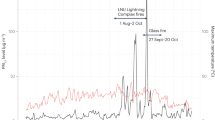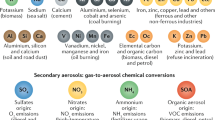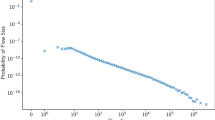Abstract
A major concern in studies that address the health effects of air pollution is whether an observed association between concentrations of a pollutant and a health outcome is all, or in part, due to the correlation between that exposure and either a second pollutant or a confounder. The addition of exposure measurement error to such data complicates matters further. To account for measurement error when data come from a multi-city study, Schwartz and Coull (2003) proposed a two-stage estimator. These authors showed via both first principles and simulation that their approach yields unbiased estimates for the parameters of interest. However, these estimates have large variability. In this paper, we describe a fully Bayesian approach that yields estimators that are much more efficient than the existing two-stage measurement error correction yet still unbiased. The proposed approach can also incorporate additional exposures or confounders without requiring strict assumptions that are necessary in existing formulations of the model. We compare the properties of the Bayesian estimators to existing approaches via simulation.
This is a preview of subscription content, access via your institution
Access options
Subscribe to this journal
Receive 6 print issues and online access
$259.00 per year
only $43.17 per issue
Buy this article
- Purchase on Springer Link
- Instant access to full article PDF
Prices may be subject to local taxes which are calculated during checkout





Similar content being viewed by others
References
Berry S.M., Carroll R.J., and Ruppert D. Bayesian smoothing and regression splines for measurement error problems. J Am Stat Assoc 2002: 97: 160–169.
Besag J., Green P., Higdon D., and Mengersen K. Bayesian computation and stochastic systems (with discussion). Stat Sci 1995: 10: 3–66.
Carroll R.J., Crainiceanu C.M., Tosteson T.D., and Karagas M.R. Nonlinear and nonparametric regression and instrumental variables. J Am Stat Assoc 2004: 99: 736–750.
Carroll R.J., Ruppert D., and Stefanski L.A. Measurement Error in Nonlinear Models 1995, Chapman & Hall, New York.
Cowles M.K., and Carlin B.P. Markov chain Monte Carlo convergence diagnostics: a comparative study. J Am Stat Assoc 2004: 91: 883–904.
Fitzmaurice G.M., Laird N.M., and Ware J. Applied Longitudinal Analysis 2004, Wiley, New York.
Gryparis A., Paciorek C.J., and Coull B.A. Measurement error caused by spatial misalignment in environmental epidemiology. Harvard University Biostatistics Working Paper Series. Paper 59 2006: http://www.bepress.com/harvardbiostat/paper59.
Judge G.G., Griffiths W.E., Hill R.C., Ltkepohl H., and Lee T.C. The Theory and Practice of Econometrics 1985, Wiley, New York.
Sarnat J.A., Schwartz J., Catalano P.J., and Suh H.H. Gaseous pollutants in particulate matter epidemiology: confounders or surrogates? Environ Health Perspect 2001: 109: 1053–1061.
Schwartz J., and Coull B.A. Control for confounding in the presence of measurement error in hierarchical models. Biostatistics 2003: 4: 539–553.
Waller L.A., Carlin B.P., Hong X., and Gelfand A.E. Hierarchical spatio-temporal mapping of disease rates. J Am Stat Assoc 1997: 92: 607–617.
Zeger S.L., Thomas D.C., Dominici F., Samet J.M., Schwartz J., Dockery D., and Cohen A. Exposure measurement error in time-series studies of air pollution: concepts and consequences. Environ Health Perspect 2000: 108: 419–426.
Zeka A., and Schwartz J. Estimating the independent effects of multiple pollutants in the presence of measurement error: an application of a measurement-error-resistant technique. Environ Health Perspect 2004: 112: 1686–1690.
Acknowledgements
We thank Thomas Bateson and Jee-Young Kim from the U.S. EPA for the invitation to participate in the workshop on which this special issue is based. We also thank two referees and the Editor for helpful comments that improved the manuscript. This research was partially supported by NIEHS Grants ES012044, EPA Grant R832416, and American Chemistry Council Grant 2843. It has not been formally reviewed by the American Chemistry Council and the views expressed in this document are solely those of the authors.
Author information
Authors and Affiliations
Corresponding author
Appendix
Appendix
Here, we provide the WinBUGS code that one can use to fit a linear health effects model using two correlated exposures. The following code can be easily modified to accommodate different scenarios (e.g. adding more covariates with or without measurement error, categorical outcomes, etc.).
model
{
for (o in 1:n.all)
{
mean[o] <- beta0 + beta1*x[o,1] + beta2*x[o,2]
w[o,1] ∼ dnorm(x[o,1], tau.u1)
w[o,2] ∼ dnorm(x[o,2], tau.u2)
y[o] ∼ dnorm(mean[o],tau.y[city[o]])
w[o,1:2] ∼ dmnorm(mu.x[city[o],],
tau.all[(2*city[o] 1):(2*city[o]),])
}
for (i in 1:n.city)
{
mu.x[i,1] ∼ dnorm(0, 0.001)
mu.x[i,2] ∼ dnorm(0, 0.001)
oriz[i] <- sigma2.x1*sigma2.x2*(1-pow(rho[i],2))
tau.all[(2*i-1),1] <- sigma2.x2/oriz[i]
tau.all[(2*i),2] <- sigma2.x1/oriz[i]
diag.el[i] <- -pow(sigma2.x1,.5)*pow(sigma2.x2,.5)*
rho[i]/oriz[i]
tau.all[(2*i-1),2] <- diag.el[i]
tau.all[(2*i),1] <- diag.el[i]
rho[i] ∼ dunif(-.99,.99)
tau.y[i] ∼ dgamma(0.01,0.01)
}
beta0 ∼ dnorm(0,0.001)
beta1 ∼ dnorm(0,0.001)
beta2 ∼ dnorm(0,0.001)
tau.u1 ∼ dgamma(0.01,0.01)
tau.u2 ∼ dgamma(0.01,0.01)
tau.x1 ∼ dgamma(0.01,0.01)
tau.x2 ∼ dgamma(0.01,0.01)
sigma2.x1 <- 1/tau.x1
sigma2.x2 <- 1/tau.x2
}
Rights and permissions
About this article
Cite this article
Gryparis, A., Coull, B. & Schwartz, J. Controlling for confounding in the presence of measurement error in hierarchical models: a Bayesian approach. J Expo Sci Environ Epidemiol 17 (Suppl 2), S20–S28 (2007). https://doi.org/10.1038/sj.jes.7500624
Received:
Accepted:
Published:
Issue Date:
DOI: https://doi.org/10.1038/sj.jes.7500624



